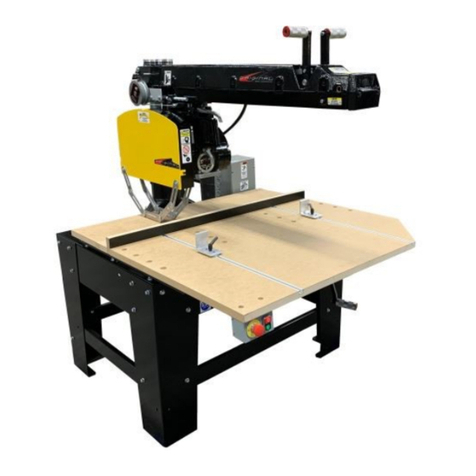5
Modifications:
− • Any modifications to the machine including in-
corporation into an assembly, addition of integrat-
ed feeds or other changes are the responsibility of
the end user and the end user must ensure ongo-
ing compliance.
Additional Safety Actions to be Take by End
User
− • Lock out Tag out procedures to be adopted dur-
ing all maintenance.
− • Lock out Tag out procedures to be observed
when changing blade
Functional Testing
− • Braked run down times test—tested monthly
(30 second brake run down )
− • Upper Guard locking—tested monthly, prove
there is an inability to open upper guard without
tools.
− • Test lower guards for hang ups make sure upper
plastic section drop down to cover blade
− • Test lower ring guard (inner) test to make sure it
moves freely, it is not bent, and does not hang up–
must drop freely to lower portion of blade
Instructions for Use:
− • Always observe the safety instructions and
applicable regulations.
− • Ensure the material to be sawn is firmly secured
in place.
− • Apply only a gentle pressure to the tool and do
not exert side pressure on the saw blade.
− • Avoid overloading.
− • Install the appropriate saw blade.
− • Do not use excessively worn blades.
− • The maximum rotation speed of the tool must
not exceed that of the saw blade.
− • Do not attempt to cut excessively small pieces.
− • Allow the blade to cut freely. Do not force.
− • Allow the motor to reach full speed before
cutting.
− • Make sure all locking knobs and clamp handles
are tight.
− • Never run the machine without the guards in
place.
− • Never lift the machine by the table top.
Preventative Maintenance
Original Radial Arm Saws are designed to provide
you with precision cutting with a minimal amount
of maintenance. The frequency of the mainte-
nance depends on the amount of use and the
desired cutting quality.
Always disconnect and lockout power supply
before performing maintenance.
Daily
− • Wipe down the machined tracks in the arm,
this will prevent wood pitch buildup on the
machined surfaces
− • Dust off and remove excess saw dust
Monthly
− • Repeat daily tasks but use denatured alco-
hol or paint thinner to wipe down tracks
− • Remove arbor nut, collars, and saw blade.
Inspect the saw blade teeth for sharpness
and broken tips. Replace or re-sharpen as
necessary
− • Remove end cap and remove carriage and
rest on the table (do not remove wiring) then
wipe off the bearings with denatured alcohol
or paint thinner to remove all wood pitch
buildup, DO NOT lubricate the tracks this will
case premature track wear due to sawdust
sticking to the tracks.
− • Inspect arbor, are the arbor bearings still
tight and free of play? If not then they will
need to be replaced by a technician or at a
electric motor shop.
− • Inspect all wiring to check for cracks, re-
place if worn or cracked.
− • Using compress air blow out the cooling
ducts in the motor by blowing through from
the arbor side of the motor to the back o the
motor, (use Personal Protection equipment ie
safety glasses and a face mask to protect
from the dust)
− • Dust off all surfaces using a vacuum remove
all saw dust from the table and the frame.



































